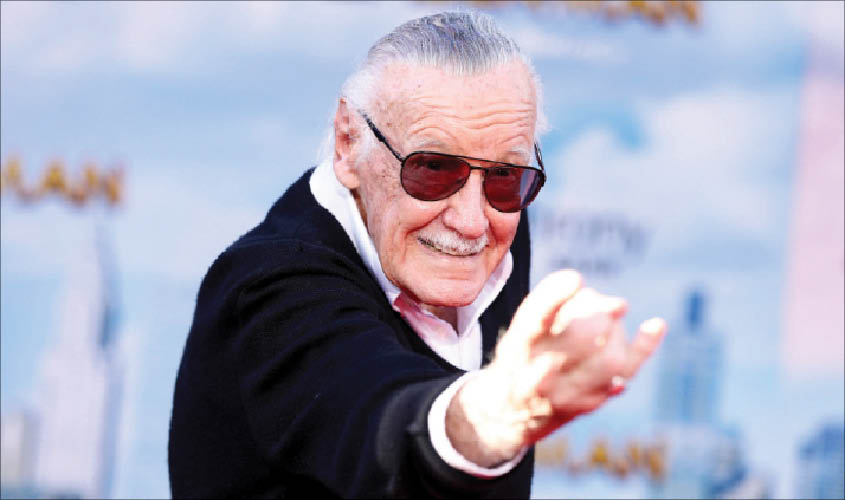Legendary comic-book writer and creator of such world-famous characters as Spider-Man, Thor and Hulk, Stan Lee passed away on 12 November at the age of 95. Bulbul Sharma writes about the universal appeal of Lee’s work and his enduring artistic vision.
“Stan Lee was as extraordinary as the characters he created… A superhero in his own right to Marvel fans around the world, Stan had the power to inspire, to entertain and to connect…,” said Disney chairman and CEO, Bob Iger, in a statement expressing remorse on the death of the iconic comic-book writer, Stan Lee, on 12 November. This tribute not only resonates with Marvel Universe fans worldwide, but also captures an important aspect of Lee’s personality. Much like his characters, Lee was blessed with a unique superpower—of creative insight and artistic genius. He was 95.
Lee was the co-creator of the biggest comic-book characters of all time: such Marvel smash hits as Black Panther, Iron Man, Spider-Man, X-Men, Thor and others. Confirming his demise, a family statement read, “J.C. Lee [Lee’s daughter] and all of Stan Lee’s friends and colleagues want to thank all of his fans and well-wishers for their kind words and condolences… Stan was an icon in his field. His fans loved him and his desire to interact with them. He loved his fans and treated them with the same respect and love they gave him… He worked tirelessly his whole life creating great characters for the world to enjoy. He wanted to inspire our imagination and for us to all use it to make the world a better place. His legacy will live on forever.”
Born as Stanley Martin Lieber on 28 December 1922 to a poor family in Manhattan’s Upper West Side, Lee had a difficult childhood that was full of struggles. Money was always scarce and his family never had any stable source of income. Lee has written about his early days in his moving autobiography, Excelsior!: The Amazing Life of Stan Lee, which was published in 2002.
He was only 17 when he got his first job at a publishing company, Timely Comics—later rechristened Marvel Comics—in 1939. By the time he turned 19, Lee was made the editor-in-chief. He started to use the pen name, Stan Lee, with the publication of his first story, “The Traitor’s Revenge!”, in the third issue of Captain America.
Lee then went on to work with artists like Jack Kirby and Steve Ditko, and helped rejuvenate America’s comic-book scene as it languished, in the ’70s, under strict censorship laws and a shortage of patrons. It was in this phase of his career that Lee was pushing the boundaries by taking up “serious” subject matter—like substance abuse—in his stories.
In 1972, after having picked up three decades’ worth of experience as a scriptwriter, Lee became publisher and editorial director for Marvel Comics. He wrote prolifically, created comic strips for newspapers and published several books, including The Superhero Women in 1977 and How to Draw Comics the Marvel Way in 1978.
His style was unlike that of any other comic-book writer of his time. The superheroes he created didn’t simply dwell in the realms of make-believe and fancy. They had genuine, earthly traits to their personality. Lee made his characters emotionally vulnerable and psychologically relatable. That’s why the Mighty Thor is grappling with family problems, and Hulk is dealing with anger issues. This multidimensionality is what lends to Lee’s characters their universal appeal.
Around the year 2000, Lee also began working with Marvel’s arch rival, DC Comics, and helped them reinvent their signature characters like Superman, Batman and Wonder Woman among others. Honouring their partnership, DC Comics recently posted the following from its official Twitter handle, “[Lee] changed the way we look at heroes, and modern comics will always bear his indelible mark. His infectious enthusiasm reminded us why we all fell in love with these stories in the first place. Excelsior, Stan.”
Released in 2000, X-Men was the first big-budget Hollywood movie that brought Lee’s characters to the silver screen. This massively successful venture was followed by Spider-Man and the Avengers series. Soon Lee’s superheroes had taken Marvel Cinematic Universe to unimaginable heights. Avengers: Infinity War, featuring Marvel characters, became the highest grossing superhero movie of all time. Since the time of its release earlier this year, the movie has earned over
$2 billion in worldwide revenues.
That Lee possessed a great sense of humour becomes evident in the number of cameos he played in the Marvel films. His 20 guest appearances include the role of a security guard in Hulk (2003), a postman named Willie Lumpkin in Fantastic Four (2005), and a man watering his front yard in the neighbourhood where Jean Grey grew up in X-Men: The Last Stand (2006). We remember these glimpses as we look back on Lee’s distinguished life. Stan Lee is no more, but the universe he created remains.

